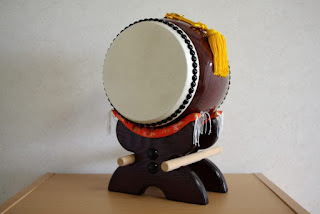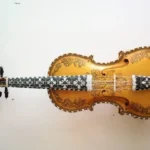
The taiko is a large, drum-like percussion instrument that is thought to have originated in Korean and Chinese culture and was introduced to Japan in the sixth century CE. Taiko have been used for a variety of purposes throughout history, including military, theatrical, religious, festival, concert, and communication. The Japanese use the term ‘taiko’ to refer to any type of drum, but those outside of Japan use it to refer specifically to Japanese drums. Taiko drums typically have a shell with heads on both sides, and the cavity is sealed to provide resonation. Some taiko are tunable, while others are not.
Taiko is also known as wadaiko, and when an ensemble plays taiko, it is known as kumi-daiko.
Building a taiko can take several years, depending on the craftsman’s process and the materials used.
When taiko were used in warfare, specific drum calls were used to communicate specific orders. The troops would know whether to advance or retreat based on the sets and beats.
Taiko are widely used in Japanese theater to create dramatic tension, rhythmic patterns, and to set the tone for the performance.
Daihachi Oguchi, a trained jazz musician, invented kumi-daiko, or taiko ensemble playing, in 1951.
To make a taiko, the craftsman must first create and shape the drum’s body. He or she must then prepare the drum skin and tune it to the drum’s head.
Traditional taiko were made from dried zelkova tree trunks. It took several years to properly dry the wood so that it did not split.
Some drum heads are air dried, which can take several years, while others are dried faster in smoke inside large warehouses.
Miyamoto Unosuke Shoten, a Tokyo-based company, has been producing taiko exclusively for the Emperor of Japan since the 1860s.
For more than 400 years, one company, Asano Taiko Corporation, has been producing taiko. It is a family-owned business.
Umetsu Daiko has been producing taiko in Hakata since 1821.
The term ‘kata’ refers to the movement and posture used when playing taiko. Kata is the primary factor used to differentiate quality in taiko performance. Musicians frequently practice in rooms with mirrors so that they can assess their posture and movement.
Clothing, how one grips the sticks, technical rhythm, and clothing worn are also used to judge taiko performance.
Taiko players must wear appropriate clothing. A thin coat and a headband are worn by many groups. Taiko styles vary depending on who is playing it and under what conditions.
Taiko groups began to appear outside of Japan in the late 1900s, including Australia, Brazil, the United States, Canada, and others.
When taiko is performed in a group, vocalists and other musicians playing woodwind and/or string instruments frequently accompany the taiko players.
Taiko FAQs: Unveiling the Power of the Japanese Drum
Taiko, the thunderous Japanese drums, have captivated audiences worldwide. Whether you’re curious about their history, eager to learn how to play, or want to delve deeper into the captivating world of taiko drumming, these FAQs will provide a comprehensive guide:
1. What is Taiko?
Taiko translates to “drum” in Japanese, but it refers specifically to traditional Japanese drums made from wood with animal hide heads. These drums come in various sizes, from the compact shime-daiko to the massive okedo-daiko. Taiko drumming is a vibrant art form with a rich history, deeply intertwined with Japanese culture and festivals.
2. What are the different types of Taiko drums?
The primary taiko types include:
-
Miya-daiko: These barrel-shaped drums have a single piece of wood for the shell and fixed heads. They produce a deep, resonant sound.
-
Oke-daiko: Constructed like barrels, oke-daiko have staves of wood for the shell and tunable heads. They offer a wider range of tones and are often used in ensembles.
-
Shime-daiko: The smallest taiko, shime-daiko have a single-piece wood shell with tunable heads. They produce high-pitched, sharp sounds and are often played while held under one arm.
-
Hira-daiko: These flat-bodied drums are played horizontally and produce a distinct, dry sound.
3. What is the history of Taiko drumming?
Taiko’s origins remain unclear, but evidence suggests their use dates back centuries in Japan. Initially associated with Shinto rituals and military campaigns, taiko gradually evolved into a performance art form. The 20th century saw a resurgence in taiko popularity, with groups like Kodo bringing it to international audiences.
4. How is Taiko played?
Taiko players use specialized sticks called bachi to strike the drum heads. Different techniques produce a variety of sounds, from powerful booms to delicate rimshots. Footwork and posture are equally important, contributing to the overall power and expressiveness of the performance.
5. Can I learn how to play Taiko?
Absolutely! Taiko schools and workshops are becoming increasingly available worldwide. Look for classes in your area or online resources. Learning taiko requires dedication and physical fitness, but it’s a rewarding experience that promotes focus, coordination, and cultural appreciation.
6. Where can I experience Taiko performances?
Many professional taiko groups tour internationally. Check local event listings or search online for upcoming performances near you. You might also find taiko demonstrations at cultural festivals or Japanese community centers.
7. What is the cultural significance of Taiko?
Taiko embodies the spirit of perseverance, discipline, and teamwork. It’s believed to ward off evil spirits, bring good fortune, and celebrate life’s important moments. The powerful rhythms of taiko connect performers and audiences, fostering a sense of community and shared energy.
8. Are there video games related to Taiko?
Yes! The “Taiko no Tatsujin” series is a popular rhythm game where players use drum controllers to replicate taiko drumming patterns. These games offer a fun introduction to taiko music and feature a vast library of Japanese and international songs.
9. How much does a Taiko drum cost?
Taiko drums range in price depending on size, quality, and materials. Beginner-friendly shime-daiko can be found for a few hundred dollars, while larger okedo-daiko can cost several thousand.
10. Where can I buy a Taiko drum?
Specialty music stores selling traditional Japanese instruments or online retailers specializing in taiko equipment are your best bets. Consider factors like your experience level and playing goals when choosing a taiko.
This comprehensive FAQ should equip you with a solid understanding of taiko drumming. As you delve deeper, you’ll discover the captivating world of taiko – a vibrant art form that continues to resonate across cultures.









